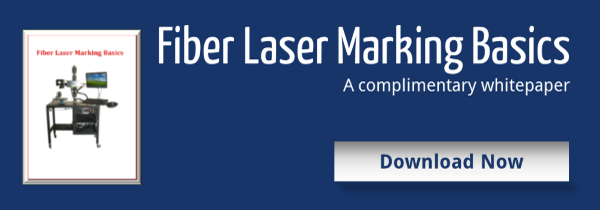
 Generally speaking, laser marking is performed using one of two laser types and one of two types of laser positioning techniques. We will explore these as we consider the question: 'What is laser marking?'
Generally speaking, laser marking is performed using one of two laser types and one of two types of laser positioning techniques. We will explore these as we consider the question: 'What is laser marking?'
Laser Types - The wavelength or color of the laser light determines what material can be marked with it. 1064 nanometer light is the best choice for marking all metals and many plastics. 1064 nanometer light is produced by YAG, YVO4 and Fiber lasers. Over the last several years, fiber lasers have begun to dominate sales of 1064 nanometer lasers because of size, efficiency, long life and durability. 10,600 nanometer light is produced by CO2 lasers and is the best choice for marking wood, many plastics and organic materials. Modern CO2 lasers also enjoy the benefits of size, efficiency, long life and durability.
The material being marked dictates the best type of laser to use. Although some materials work equally well with either type of laser, one type is generally vastly superior over the other type for a particular material. If you are marking metals, for example, there is no question that a 1064 nanometer fiber laser is the correct type of laser to use. If you are marking wood then there is no question that a 10,600 nanometer CO2 laser is the correct choice. There is no such thing as a laser that marks all materials well. IT DOES NOT EXIST.
Laser Positioning Techniques - Two types of positioning techniques are commonly used to position the laser beam over the part to be marked. One of these techniques is used in what are called “Flying Optics” Systems. The other technique is what is used in what are called “Beam Steered” Systems. Flying Optics Systems use a simple focusing lens that is attached to one axis of a gantry type positioning system. Both axes of the gantry system have mirrors mounted on them that always direct the laser beam into the focusing lens, regardless of the position of the gantry.
 In Flying Optics Systems, parts are marked by moving the focusing lens with the gantry over the area of the part where marking is desired. Flying optics systems tend to be mechanically complex and moving the lens with the gantry system is relatively slow. An advantage of flying optics systems is that the gantry systems can be made large so that a large marking field can be obtained.
In Flying Optics Systems, parts are marked by moving the focusing lens with the gantry over the area of the part where marking is desired. Flying optics systems tend to be mechanically complex and moving the lens with the gantry system is relatively slow. An advantage of flying optics systems is that the gantry systems can be made large so that a large marking field can be obtained.
Beam Steered systems use electro-magnetic galvanometers with mirrors on them to position the laser beam in the X and Y axes. The laser beam is focused onto the work surface by a more complex lens that allows the beam to focus throughout a plane under the lens rather than at just a single spot. By using the computer to control the position of the mirrors on the galvanometers, the focused laser beam can “draw” lines on the surface of the material to be marked anywhere within this plane.
Those lines can be in the form of text or graphical images. A disadvantage of steered beam systems is that they are limited to smaller marking areas than flying optics systems although the marking times are much faster. Steered beam positioning systems are also much less mechanically complex and require no maintenance or adjustment. Both types of laser beam positioning systems have applications that they are best suited for and neither one is perfect for all applications.
Either type of laser beam positioning system is available with either type of laser although 10600 nanometer CO2 systems are more commonly used with flying optics systems and 1064 nanometer Fiber lasers are more commonly used with beam steered systems. Because of the slow marking speed and large marking fields of flying optics systems, users typically rely on custom fixtures which can hold many parts at once and allow them be marked while the machine is unattended. Beam steered systems mark much faster and are frequently used by loading and marking one part at a time or connecting the system to some type of automatic feeding system that can communicate with the marker. Automation is all but impossible with flying optics systems.
Flying Optics systems act like dot matrix printers and are best suited for use with bit map (raster) images when marking. Each pixel in the bitmap image would be marked by a single laser pulse. Although most flying optics systems can also mark vector images, raster images provide more consistent results. Beam steered systems act like plotters and are best suited for vector images when marking. Although beam steered systems can also mark raster images, better results are generally obtained when vector files are used.
Contact us if we can help with any of your laser marking requirements.
Fiber Laser Markers
When looking for a fiber laser marking system there are a lot of options out there. One of the...
Types of Laser Marking
Types of laser marking generally fall into one of three categories: Ablation, Engraving and Stain...

